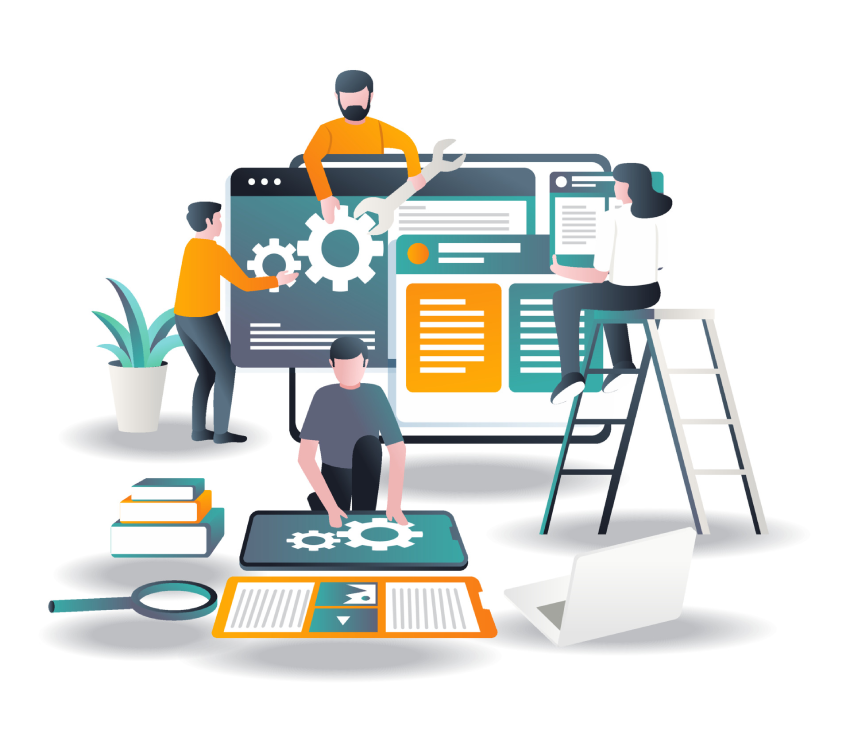A Step By Step Method of the Custom Software Development Process

Gone are the days when software development was a black art that few people were able to master. Thanks to advances in technology, today’s software developers have access to a wide range of tools and techniques that make the process of creating custom software much easier.
In this article, we will walk you through a step-by-step process of the custom software development process. We’ll explain how to determine your needs, select the right software development tools, and put together a detailed project plan. Ready? Let’s get started!
What is Custom Software Development?
Custom software development is the process of creating custom software for your own Product Idea using specific tools and techniques. This means that you will not use off-the-shelf products or libraries to create your custom software instead, you will create it from scratch using specialized programming languages, tools, and frameworks.

The benefits of custom software development include:
1) Increased flexibility and control: You have the ability to create custom software that meets your exact needs, rather than using pre-built solutions. This allows you to customize the software exactly how you want it, without having to conform to predetermined specifications or design patterns.
2) Reduced development time and costs: Custom software development can be faster and more affordable than using off-the-shelf products. By crafting your own solution from scratch, you can avoid common pitfalls and save on unnecessary costs associated with developing extensive customer-worn solutions.
3) Improved quality assurance: Customized solutions are typically more rigorous and error-free than those created using off-the-shelf solutions. This eliminates the need for extensive testing, which can save you time and money.
4) Greater synergies with other software components: Customized software is typically more integrated and holistic than standard solutions. As a result, it can be easier to integrate with other applications or systems, resulting in increased efficiency and effectiveness overall.
5) Greater adaptability: Custom software can be changed or adapted to meet specific needs without affecting the rest of the system. This makes it ideal for use in demanding, evolving environments.
6) Greater scalability: Custom software can be tailored to meet the needs of a single organization or tens of thousands of users. This allows it to grow and adapt as your needs change, without taking on excessive overhead or risk.
7) Improved security: Customized software is typically more secure and resilient than off-the-shelf solutions, making it ideal for high-risk applications such as finance or healthcare.
8) Greater focus on customer requirements: When developing custom software, you are always focused on meeting the needs of your customers. This results in solutions that are easier to use and understand, and which meet the specific needs of your business.
9) Greater agility: Custom software is typically more agile than off-the-shelf solutions, allowing you to react quickly to changing market conditions.
10) Greater control over development costs and timelines: With custom software, you are in control of the development process from start to finish. This allows you to reduce overall development costs and expedite the delivery of a high-quality solution.
11) Improved compatibility with other systems: As custom software is developed specifically for your business, it is typically more compatible with other applications and systems. This means that it can be easily integrated into existing workflows, saving time and effort overall.
Step-by-step process of the custom software development process

The custom software development process can be broken down into four distinct steps. These steps are:
Step 1: Brainstorming and Conceptualizing the Idea
The first step in the custom software development process is to brainstorm and conceptualize the idea behind your program. This includes coming up with a detailed business plan, analyzing customer needs, and developing an overall goal for your project.
Make sure your idea is solving a major public problem. If your program is simply a custom modification or add-on to an existing product, make sure the market for this type of software exists and that there is a large enough customer base to support it.
If you’re creating a new product from scratch, be sure to investigate whether any similar products are available on the market. This will help you determine whether your idea has potential and if there are any potential pitfalls or problems with developing it.
Step 2: Planning the Project
Once you have a good idea for your program, the next step is to develop a detailed plan for its development. This includes outlining the features and functionality of your program, determining which programming languages and tools will be necessary to create it, and estimating how much time and resources will be required.
Make sure you include all of the important details such as estimated costs, completion date, testing procedures, etc. This information will help ensure that your project proceeds smoothly and on schedule.
Step 3: Creating a Prototype
Once you have a detailed plan for your project, the next step is to create a prototype or test version of it. This will allow you to see how your program works and make any necessary changes before beginning full development.
A good way to create a prototype is by using an existing software program as the foundation for your new one. This will give you access to all of the features and functionality of the original program, making it easier to develop on top of existing code.
If creating a prototype isn’t feasible or desirable, then you can use mockups or wireframes to help visualize the layout and structure of your program. This will allow you to more easily evaluate potential design changes and determine the feasibility of implementing them.
Step 4: Testing the Prototype
Once you have a prototype version of your program ready, it’s time to test it to make sure it works as expected. This includes running various tests and ensuring that all the features and functionality are working correctly.
If there are any areas where the program is problematic or does not work as intended, fix these issues before proceeding with full development. Doing so will ensure that your project is error-free when finished.
A thorough check of your prototype prior to beginning full development will save you time and money later on.
Step 5: Designing the User Interface
Once the prototype is complete and tested, it’s time to begin designing the user interface. This will involve creating mockups or wireframes of all of the screens in your program, as well as figuring out how they should interact with each other.
For example, should the user interface look and feel similar to the original program, or should it be completely redesigned? Once you have a finalized design for the user interface, it’s time to start generating code. This will all be done in a programming language of your choice, and once finished, your prototype will be ready for testing again.
This process can be tricky and time-consuming, but it’s important that you get everything right. The improper design could lead to frustrated users and a failed project – don’t make this mistake!
And, of course, don’t forget to test the user interface before finalizing it – again, this will save you embarrassment and potential headaches.
Step 6: Coding the Software
Once the user interface is finalized, it’s time to start coding. This will involve creating a source code version of your program using an appropriate programming language.
Making sure that the code is well organized and easy to follow is key here – if you can’t navigate through it easily, no one else will be able to either!
And remember: always test your software before finalizing it – even beta versions are good practice! Make sure the codes and user interfaces look good on all devices and browsers.
Once the code is complete, it’s time to test it – again, this is an important step that can save you a lot of frustration later on. If there are any problems with your program, address them now before they become bigger problems!
Step 7. Testing the Software
Once the software is tested and ready to go, it’s time to market it! This will involve creating a marketing plan and spreadsheets, as well as advertising your program on various websites and social media platforms.
Again, make sure all of your preparations are in place before you launch – if things don’t go according to plan, you could end up with a disastrous outcome. Follow through with your plans until the very end; failure isn’t an option when it comes to launching a successful business!
Keep in mind that it takes a lot more than just good software to make a successful business. It takes dedication, hard work, and sometimes even luck – but if you put in the effort and follow the steps outlined in this guide, you can achieve anything you want!
Step 8. Implementing the Software
Well, implementation is finally here! After all of the hard work, it’s time to actually see your software in action. This can be a thrilling experience, as you watch people start using and enjoying your product.
Make sure you’re prepared for this moment – not only do you need to have the code ready, but also make sure everything is set up properly on the website and devices used for testing. Be honest with users while they are testing – if something isn’t working right, tell them so immediately and try to resolve the issue. Also, make sure to keep a record of all bug reports and feedback so you can address them in future updates or releases.
With implementation complete, it’s time to take stock of your success: did everything go as planned? Did users love the new features? Was there any negative reaction from anyone? If not, what needs to be fixed before continuing with the project? Keep track of everything so you can continue improving your product!
Step 9: Maintaining the Software
Maintaining a software project is essential for its success. After all of the hard work, it’s important to make sure that your product continues to meet users’ expectations – and this isn’t always easy.
There are always new features that can be added, bug fixes that need to be made, or improvements that can be made overall.
For example: In order to keep track of all these changes, you’ll need a system in place for tracking milestones and progress reports (just like you did when implementing the software). This way, everyone involved with the project will have an easy way to see where things are at and make sure that deadlines are met.
Another important part of maintaining a software project is making sure users can access the product when they need it. This means ensuring that the website is always up and running, as well as checking for any technical problems with devices used for testing (e.g., broken links or inaccessible files). If necessary, you’ll need to address these issues immediately so users can continue using your product.
Remember: good maintenance isn’t about doing less work – it’s about keeping everything running smoothly in order to ensure users’ satisfaction with the product.
Conclusion
In addition to the above-mentioned benefits, custom software development is also considered as a more cost-effective solution. Also, the step-by-step procedure mentioned above enables the developers to precisely plan, track and manage the project properly. This ultimately leads to better quality output as well.
If you are looking for a way to speed up your business growth, consider hiring the right professionals and getting involved in custom software development company. This will not only help you achieve desired results faster but also save time and money in the long run.
To know more about how your business can benefit from this innovative method, contact ARKA Software today. Our team of experts will be more than happy to discuss your specific needs and answer any questions you may have.
Also, we make sure to keep our pricing transparent and competitive so that you can make the best decision for your company.